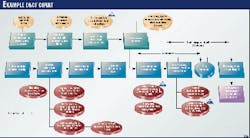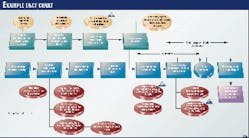After an incident in 1998 during which a tank collapsed in its petrochemical manufacturing plant in Port Neches, Tex., Huntsman Corp. used a systematic way to investigate the incident and keep it from happening again.
Before this incident, the company had adopted an investigation method developed by System Improvements Inc., Knoxville, Tenn., called TapRooT.
The system is used to find the root cause of an incident. An investigation team analyzes the events that caused the accident and then uses the TapRooT process to find root causes and develop recommendations.
Huntsman estimates that it saved more than $1 million/year by avoiding unplanned events identified in this particular study.
Incident
During a 1998 turnaround for the propylene oxide/methyl tertiary butyl ether (MTBE) unit, a large tank collapsed as a result of rapid steam condensation. The steam was being used to prepare the tank for maintenance work.
The rapid condensation occurred when the deluge system was accidentally activated. An electrician had removed a faulty bulb in one of the relays for the deluge system's electrical power supply, which set off the deluge system.
Don Guidry, one of the process safety management coordinators for Huntsman, looked for a systematic way to investigate the incident and to reduce chances of it happening again. He also sought to improve Huntsman's already excellent safety record; that is, reduce the number of accidents with injuries, loss of property, fires, and explosions.
The goal was to investigate and learn how to prevent the recurrence of the collapse of a process tank, which caused severe damage to the tank and required significant replacement costs.
Investigation
All participants in the investigation process must be trained. Guidry, a TapRooT-trained facilitator and instructor, led the investigation. His first step was to teach the designated team how to conduct an investigation.
To save time, Guidry decided to use the lunch hour, with lunch catered, to conduct meetings. This reduced interruptions to the turnaround.
The investigation of the tank incident took four sessions, 1 to 3 days apart--a total of 9 hr. The efficiency of the investigation process was essential. The investigation was conducted while turnaround activities were taking place and thus had to compete with turnaround resources.
Also, the schedule had allotted only 2 weeks for repairs on this tank, and the scope of additional work was limited until the recommendations from the investigation were complete. According to Guidry, the investigation had a minimal impact on the operations and maintenance organizations.
As a result of the meeting, the team developed corrective actions to prevent the incident from recurring.
TapRooT uncovered an interesting problem about the thoughts and work processes of plant personnel. There was a reluctance on the part of plant personnel to remove any safeguard from service. In this particular incident, workers were reluctant to disable the deluge system when the tank was serviced.
In one of many branches of reasoning, had the deluge system been turned off, the tank would not have collapsed. The team outlined a decision-making process to decide when a safeguard should be disabled.
This was developed into a checklist for taking systems out of service. The checklist addressed the effects of safeguards that will be left in service, the hazards posed by safeguards left in service, and if a safeguard is to be taken out of service, the process and timing to do so.
Guidry believes this would not have been identified had the investigation system not been used. He said, "TapRooT helps us do the most logical thing in a quick unequivocal manner. We may not like the results--it may point a finger directly at me--but it's the right answer in most of the cases we've looked at."
How TapRooT works
The purpose of TapRooT, as its name says, is to perform a root-cause analysis. Among other techniques, two core-incident investigation techniques are used: Events and Causal Factors (E&CF) charting and the TapRooT Root Cause Tree.
Interviewing is a key source of information in these analyses. Through the use of a very simple checklist, the investigation process breaks down the problem into fractions to lead to a conclusion.
Although at one time the analysis was done on the board, software streamlines the analysis today. The software has a friendly user interface, and a draft report can be completed 5 min after the study is done.
Guidry estimates that the investigation system saves his company several million dollars/year. He bases his estimates on the elimination of expensive and dangerous unplanned events during maintenance.
At the first meeting, the team draws the first E&CF chart to understand the incident better. An example of an E&CF chart drawn for this article is shown in Fig. 1. After creating the E&CF chart, the team uses the TapRooT Root Cause Tree to follow causes down to their root causes.
Initial causes fall in one of four categories: human performance difficulty, equipment difficulty, natural phenomenon/sabotage, and other. In the end, root causes are chosen from the following basic cause categories:
- Procedures
- Training
- Quality control
- Communications
- Management system
- Human engineering
- Immediate supervision.
These basic causes are further divided into more-specific causes.
Today, Huntsman has two employees who are certified TapRooT instructors and plans to certify another one this year.



